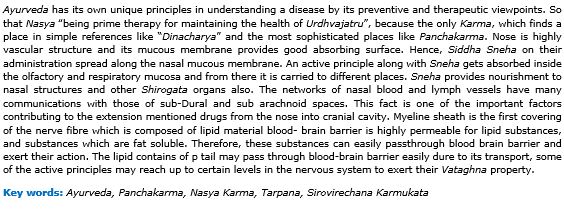Nasya Karmukta with special reference to pharmacodynamics of Nasya
DOI:
https://doi.org/10.21760/jaims.8.3.11Keywords:
Ayurveda, Panchakarma, Nasya Karma, Tarpana, Sirovirechana KarmukataAbstract
Ayurveda has its own unique principles in understanding a disease by its preventive and therapeutic viewpoints. So that Nasya ‟being prime therapy for maintaining the health of Urdhvajatru”, because the only Karma, which finds a place in simple references like “Dinacharya” and the most sophisticated places like Panchakarma. Nose is highly vascular structure and its mucous membrane provides good absorbing surface. Hence, Siddha Sneha on their administration spread along the nasal mucous membrane. An active principle along with Sneha gets absorbed inside the olfactory and respiratory mucosa and from there it is carried to different places. Sneha provides nourishment to nasal structures and other Shirogata organs also. The networks of nasal blood and lymph vessels have many communications with those of sub-Dural and sub arachnoid spaces. This fact is one of the important factors contributing to the extension mentioned drugs from the nose into cranial cavity. Myeline sheath is the first covering of the nerve fibre which is composed of lipid material blood- brain barrier is highly permeable for lipid substances, and substances which are fat soluble. Therefore, these substances can easily passthrough blood brain barrier and exert their action. The lipid contains of p tail may pass through blood-brain barrier easily dure to its transport, some of the active principles may reach up to certain levels in the nervous system to exert their Vataghna property.
Downloads
References
Charak Samhita I & II Part, Pt. Kashinath Shastri, Dr. G.N. Chaturvedi, Reprinted, Chaukhamba Visvabharti Varanasi, 1998Cha. Si. 2/22
Vagbhata; Astanga samgraha, Sutrasthana, 29th Chapter, 2nd Sloka, Vol – 1, Page No. 511, Translation by K.R.Srikantha Murthy, Chaukhambha Orientalia.A.S.su29/2.
Sushruta, Sushruta Samhita, Ayurveda Tatvasandipika Hindi Commentary, by Kaviraja Ambika Datta Shastri. 17 th ed., Su. Sharira. 4/30, Varanasi: Chaukhambha Sanskrita Sansthana, 2003. Su. Sha. 6/27
Sushruta, Sushruta Samhita, Ayurveda Tatvasandipika Hindi Commentary, by Kaviraja Ambika Datta Shastri. 17 th ed., Su. Sharira. 4/30, Varanasi: Chaukhambha Sanskrita Sansthana, 2003. Su. Chi. 40/40.
Bhavaprakash Samhita – Vidyotini commentary, Shri. Harihar Prasad Pandey, 11th Edition, Chaukhamba Sanskrit Bhawan, Varanasi, 2009.
Sushruta, Sushruta Samhita, Ayurveda Tatvasandipika Hindi Commentary, by Kaviraja Ambika Datta Shastri. 17 th ed., Su. Sharira. 4/30, Varanasi: Chaukhambha Sanskrita Sansthana, 2003. Su. Chi. 40/30).
Ksembulingam, Essential of Medical physiology, Edition fourth, Published by JP., 2006.
Sarangdhar, Sharangdhar Samhita, Dipika Hindi Commentary, by Dr. Brahmanand Tripathi, Revised ed., Sarangdhar poorva khand 5/84, Varanasi: Chaukhambha Subharti Prakashan, 2013.
Charak Samhita I & II Part, Pt. Kashinath Shastri, Dr. G.N. Chaturvedi, Reprinted, Chaukhamba Visvabharti Varanasi, 1998 Ch. Sha.8/19
Gray’s Anatomy – 35th edition, Page No.884















